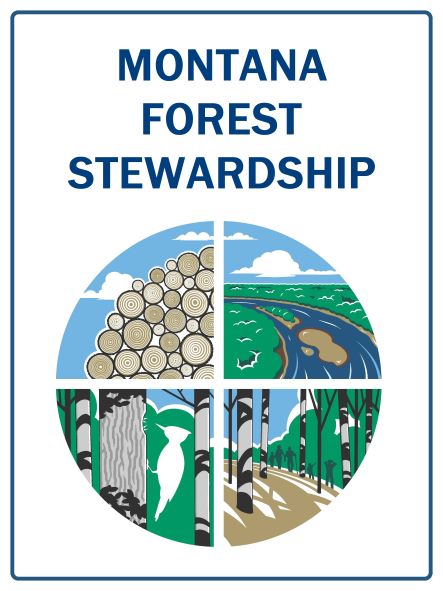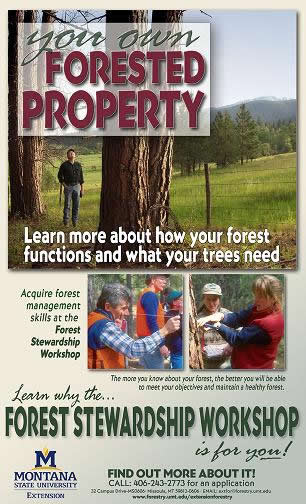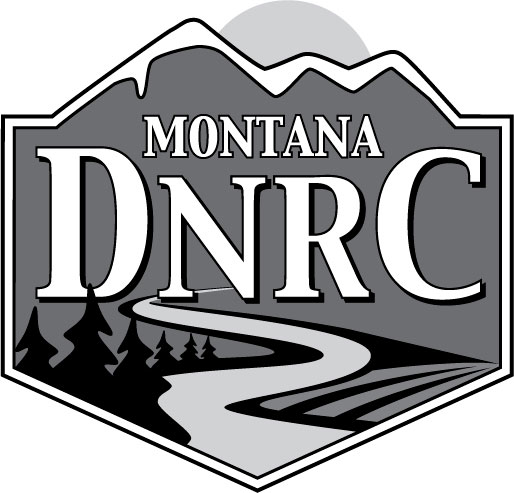Forest Stewardship Program
 Forest Stewardship Program
Forest Stewardship Program
Introduction2024 Forest Stewardship Summary
|
Workshop Schedule/Online RegistrationBrochure/mail-in registration (If registering by mail please call to preregister as classes fill quickly with online registrations) |
Spotlights: read stories from Forest Stewards |
Principles |
Pre-Workshop Materials |
|
Steering Committee |
Stewardship Plan |
MT DNRC Hazardous Fuels Reduction Program |
Forest Stewardship Workshops

Write your own Forest Stewardship Plan
Your forest is managed by you and driven by your objectives.
By identifying your primary goals and concerns, and objectively formulating an action
plan based on best available science and biological surveys of your land, we will
help you develop a Forest Stewardship Plan that is nationally accredited and certifiable.
Why should I attend?
Learn about your forest, what species do you have, how are they growing, how old are your trees, what animals share your forest?
Establish your own objectives for your forest, inventory your forest, and write a plan to help you reach your goals and may qualify your forest land for cost share opportunities.
Receive a personalized site visit with a natural resource professional.
Discover more about...
-
FOREST ECOLOGY
Your forest consists of water, soil, plants, animals, trees and much more. Learn how they interact and impact forest health. -
FIRE RISK MANAGEMENT
Fires and insect outbreaks are a reality in western forests. Learn more about influencing disturbance events and making your forest more defensible and resilient to their impacts. -
WILDLIFE HABITAT ENHANCEMENT
Wildlife need food, water, cover, and space. Discover how you can enhance habitat for various species. -
TREES - the OVERSTORY
Learn about the trees on your property, their condition and what they need to thrive and regenerate. -
UNDERSTORY and RANGE MANAGEMENT
Wildflowers, shrubs, seedlings, and weeds: forests have them all. Learn to identify plants, enhance some, and control others. -
FOREST HEALTH ASSESSMENT & MAINTENANCE
What is a healthy forest? Use an inventory to take a critical look at the components of your forest. Assess its age, health risks, growth potential, and the options you have to improve its current condition.
Classes are taught by a team of natural resource professionals.
Each workshop includes....
Home-study videos and instructions to prepare for class can be completed on your own schedule.
Day 1 Check-in: 7:30 - 8:00 a.m. Indoor class 8 a.m. - 5 p.m.
Day 2 Outdoor 8 a.m. - noon & Indoor 1 p.m. - 5 p.m.
Between Days 2 and 3 Inventory your property.
You will be supplied with equipment necessary to perform a stewardship inventory on your property. This can be accomplished in the evenings after work for smaller properties (<20 ac.), or may take a couple days for larger properties.
Day 3 Indoor class: 8 a.m. - 5 p.m.
On-site Consultation Following the Workshop
As Scheduled After you complete your plan, a Certified Stewardship Advisor will visit you, at no additional cost, at your forest for about 2-6 hours. This is a great opportunity to consult with a resource professional about your objectives, your forest, and your Forest Stewardship Plan.
Montana forests are valued for wildlife, fisheries, livestock grazing, watershed protection, recreation, and wood products. Nearly two-thirds of Montana's 23 million acres of forest land is publicly owned, mostly by Federal Government agencies. The next largest ownership is Non-Industrial Private Forest (NIPF) landowners. These 50,000+ individuals control over twice the acreage of the forest products industry. NIPF owners and their 3.8 million acres are the focus of the Forest Stewardship Program. Montana State University (MSU) Extension Forestry operates from the premise that there is a lot landowners can do for themselves if given the know-how. We believe in empowerment through personal involvement. Our goal is to help develop a lifelong relationship between a landowner and their property. We concentrate on developing critical thinking skills, problem-solving and decision-making skills. We teach people to observe, measure, gather and classify data. This results in the ability to discuss, interpret, and predict. Participants can then assess the trade-offs and consequences of their management activities and make informed decisions.
Further Readings:
Thesis: Assessing the Short and Long-Term Effects of Forest Planning Workshops for Family
Forests
Snapshot: Montana Forest Stewardship Program: A Snapshot
Sponsorship: This program is funded in part from a federal award of the U.S. Forest Service, Department of Agriculture, subawarded by the Montana Department of Natural Resources and Conservation Forestry Division to Montana State University Extension.


updated 12/10/2024
